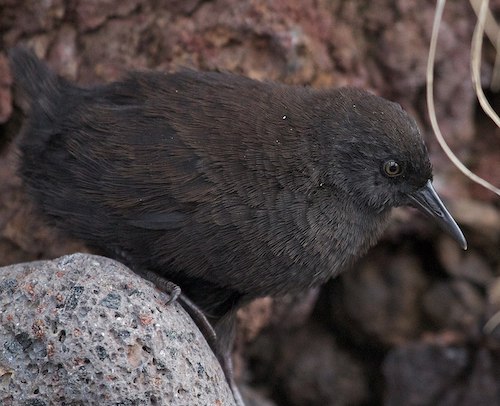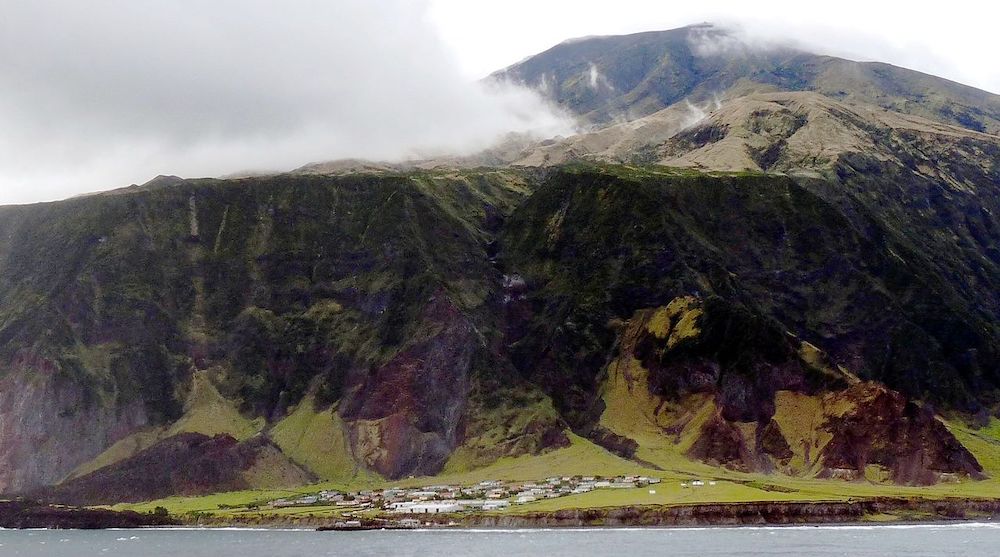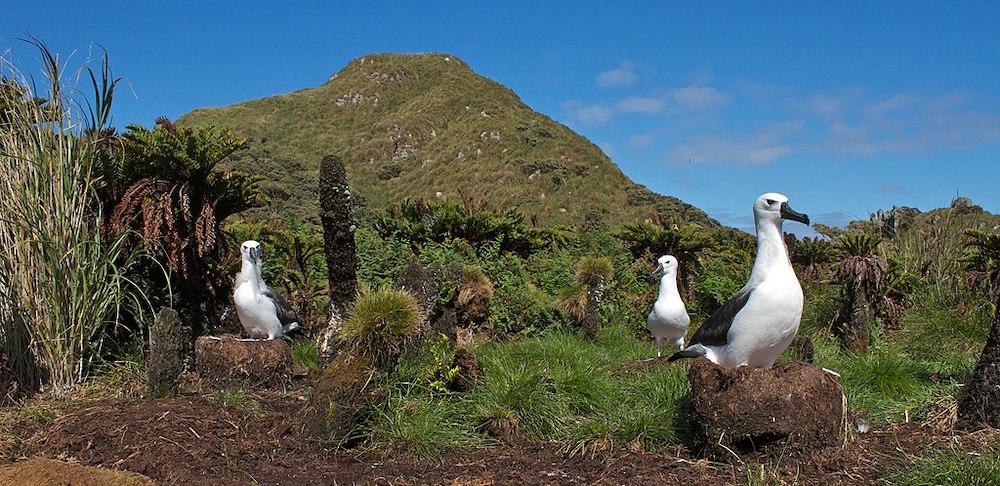Tristan da Cunha

Tristan da Cunha is a remote group of volcanic islands in the South Atlantic Ocean. It is the most remote inhabited archipelago in the world, lying approximately 2,787 kilometres from Cape Town in South Africa, 2,437 kilometres from Saint Helena, 3,949 kilometres from Mar del Plata in Argentina, and 4,002 kilometres from the Falkland Islands. The territory consists of the inhabited island, Tristan da Cunha, which has a diameter of roughly 11 kilometres (6.8 miles) and an area of 98 square kilometres (38 square miles); the wildlife reserves of Gough Island and Inaccessible Island; and the smaller, uninhabited Nightingale Islands. The main island has about 250 permanent inhabitants, who all carry British Overseas Territories citizenship. The other islands are uninhabited, except for the South African personnel of a weather station on Gough Island. Tristan da Cunha is one of three constituent parts of the British Overseas Territory of Saint Helena, Ascension and Tristan da Cunha, with its own constitution. There is no airstrip on the main island; the only way of travelling in and out of Tristan is by ship, a six-day trip from South Africa.
The main island is generally mountainous. The only flat area is on the north-west coast, which is the location of the only settlement, Edinburgh of the Seven Seas, and the agricultural area of Potato Patches. The highest point is the summit of a volcano called Queen Mary’s Peak at an elevation of 2,062 metres (6,765 ft), high enough to develop snow cover in winter. The other islands of the group are uninhabited, except for a weather station with a staff of six on Gough Island, which has been operated by South Africa since 1956 and has been at its present location at Transvaal Bay on the southeast coast since 1963.

Queen Mary’s Peak behind Edinburgh of the Seven Seas – ©michael clarke stuff, CC BY-SA 2.0 via Wikimedia Commons
The archipelago has a wet oceanic climate, with mild temperatures and very limited sunshine, but consistent moderate-to-heavy rainfall due to the persistent westerly winds. The number of rainy days is comparable to the Aleutian Islands at a much higher latitude in the northern hemisphere, while sunshine hours are comparable to Juneau, Alaska, 20° farther from the equator. Frost is unknown below elevations of 500 metres (1,600 ft), and summer temperatures are similarly mild, never reaching 25 °C. Sandy Point on the east coast is reputed to be the warmest and driest place on the island, being in the lee of the prevailing winds.
Many of the flora and fauna of the archipelago have a broad circumpolar distribution in the South Atlantic and South Pacific Oceans. Efforts to decrease and eradicate invasive flora, fauna, and marine species have been undertaken, including a programme aimed at eradicating predatory invasive mice on Gough Island. The RSPB and Tristan da Cunha Government have partnered to spread cereal pellets with rodenticide bait across Gough Island, in hopes to eradicate the invasive mice population.[87] The goal of this operation is to restore Tristan da Cunha to its natural state, ensuring it will still be one of the world’s most important seabird nesting sites.
Birding Tristan da Cunha
Gough Island was inscribed as a UNESCO World Heritage Site in 1995 as Gough Island Wildlife Reserve. This was further extended in 2004 as Gough and Inaccessible Islands, with its marine zone extended from 3 to 12 nautical miles. These islands have been Ramsar sites – wetlands of international importance – since 20 November 2008.
Tristan is primarily known for its wildlife. The island has been identified as an Important Bird Area by BirdLife International because there are 13 known species of breeding seabirds on the island and two species of resident land birds. The seabirds include Northern Rockhopper Penguins, Atlantic Yellow-nosed Albatrosses, Sooty Albatrosses, Atlantic Petrels, Great-winged Petrels, Soft-plumaged Petrels, Broad-billed Prions, Grey Petrels, Great Shearwaters, Sooty Shearwaters, Tristan Skuas, Antarctic Terns and Brown Noddies. Tristan and Gough Islands are the only known breeding sites in the world for the Atlantic Petrel. Inaccessible Island is also the only known breeding ground of the Spectacled Petrel. The Tristan Albatross is known to breed only on Gough and Inaccessible Islands: all nest on Gough, except for one or two pairs which nest on Inaccessible Island.

Albatrosses nesting in Fernbush plant communities dominated by the endemic tree-fern Blechnum palmiforme on Nightingale Island – ©Brian Gratwicke, CC BY 2.0 via Wikimedia Commons
The endemic Tristan Thrush, also known as the ‘starchy’, occurs on all of the northern islands and each has its own subspecies, with Tristan birds being slightly smaller and duller than those on Nightingale and Inaccessible. The endemic Inaccessible Island Rail, the smallest extant flightless bird in the world, is found only on Inaccessible Island. In 1956, eight Gough Moorhens were released at Sandy Point on Tristan and have subsequently colonised the island
Gough Island is also home to the critically endangered Gough Finch (sometimes called Gough Bunting). The Brown Skua is the top predator of the island’s ecosystem, feeding on other seabirds as well as land birds such as the Inaccessible Island Rail. However, birds of prey such as Barn Owl and the Amur Falcon are very occasional visitors.
-
Wikipedia
Webpage
-
Number of bird species: 94
(As at August 2024)
Number of endemics: 7
Inaccessible Rail Laterallus rogersi
Gough Moorhen Gallinula comeri
Tristan Thrush Turdus eremita
Inaccessible Finch Nesospiza acunhae
Nightingale Island Finch Nesospiza questi
Wilkins's Finch Nesospiza wilkinsi
Gough Island Finch Rowettia goughensisNumber of endemics: 1 Breeding Endemic
This species nest only on Tristan da Cuna & Gough islandsSpectacled Petrel Procellaria conspicillata
-
Avibase
PDF ChecklistThis checklist includes all bird species found in Tristan da Cunha Islands , based on the best information available at this time. It is based on a wide variety of sources that I collated over many years. I am pleased to offer these checklists as a service to birdwatchers. If you find any error, please do not hesitate to report them.
-
African Bird Club - Tristan da Cunha
WebpageThere are two main groups of islands off southern Africa: the Tristan da Cunha archipelago and Gough Island (dependencies of Saint Helena which is an overseas territory of the United Kingdom) in the central South Atlantic, and the Prince Edward Islands (administered by South Africa) in the south-west Indian Ocean. Further south lie Bouvet and the Antarctic continent, which support even fewer species, but these include several spectacular and sought-after birds. Together, more than 50 species of seabirds breed in the African sector of the Southern Ocean, and several other species regularly visit these waters. -
RSPB - Tristan da Cunha Marine Protection Zone
WebpageThanks to the work by the Tristan community, the RSPB and partners, a vast marine protection zone has been designated in the South Atlantic.
-
Blue Marine Foundation
WebpageSatellite ViewThe tiny community on the world’s remotest island has protected a tract of ocean three times the size of the UK -
NR IBA Inaccessible Island
InformationSatellite Viewnaccessible Island is a volcanic island located in the South Atlantic Ocean, 31 km (19 mi) south-west of Tristan da Cunha. Its highest point, Swale's Fell, reaches 581 m (1,906 ft), and the island is 12.65 km2 (4.88 sq mi) in area. The volcano was last active approximately one million years ago and is now extinct.
-
BirdQuest
Tour OperatorATLANTIC ODYSSEY – South Georgia, Gough, Tristan da Cunha, St Helena, Ascension and Cape Verde Islands, with Antarctica Extension -
FieldGuides
Tour OperatorExceptional seabirding opportunities on this re-positioning cruise that includes South Georgia, the Tristan da Cunha island group, and St. Helena. -
Tropical Birding
Tour OperatorThe Mid Atlantic islands of Tristan da Cunha, Saint Helena, and Gough are among the most remote inhabited places on Earth. This once-in-a-lifetime voyage takes you to several of the Mid Atlantic islands. -
WilldWings
Tour Operator...we consider this to be one of the ‘ultimate’ pelagic trips as the ship sails northwards from Ushuaia (at the very bottom of South America) to South Georgia, Tristan da Cunha and St Helena before continuing onwards to Ascension Island and the Cape Verdes...
-
2023 [03 March] - Edward Shaw
Report...Occasionally, we caught glimpses of the Tristan thrush and nightingale bunting popping out of the grasses along the coastline...
